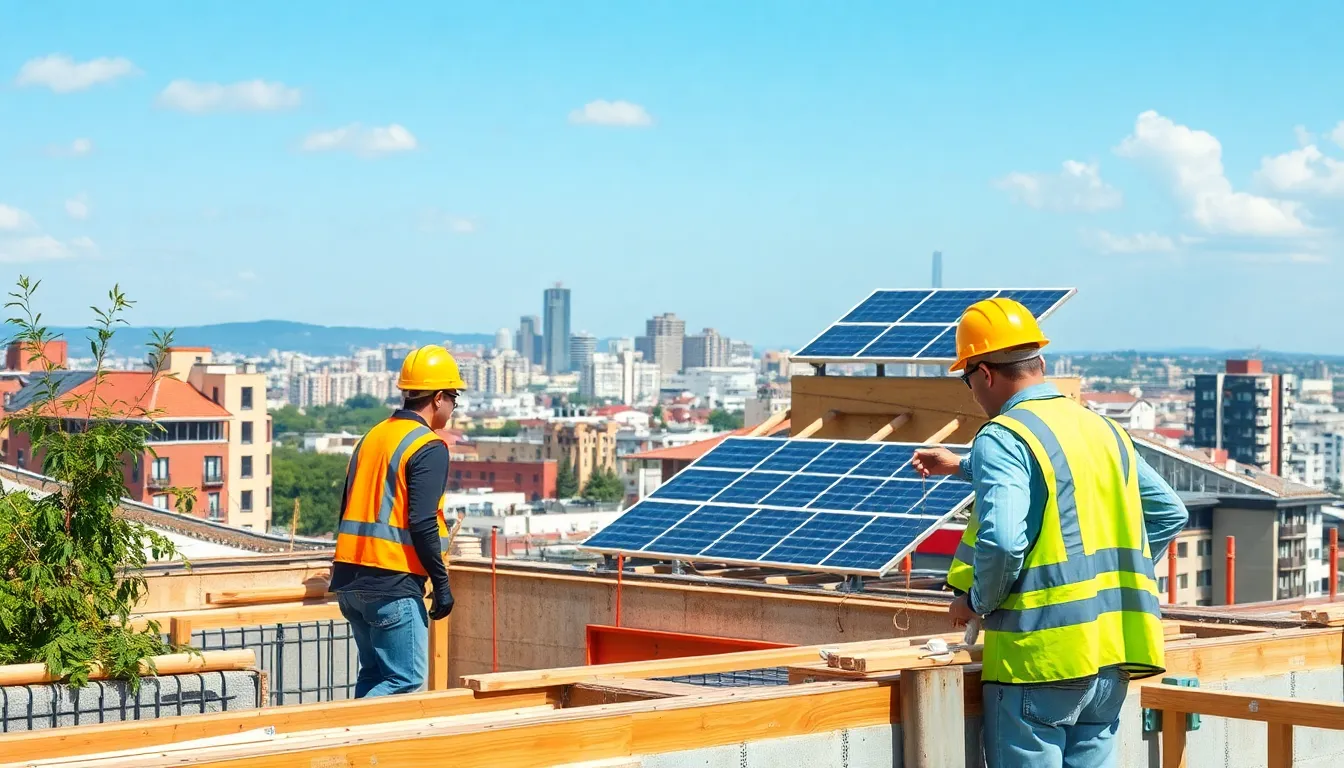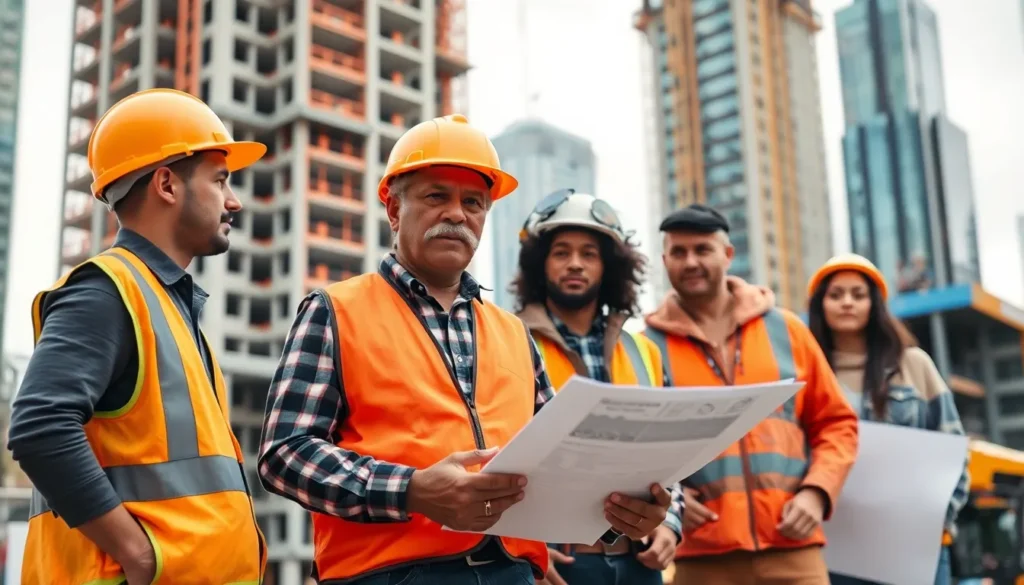In a world where buildings are getting taller and smarter, construction trends are evolving faster than you can say “blueprint.” From eco-friendly materials to cutting-edge technology, the construction industry is buzzing with innovations that not only shape skylines but also redefine how we think about spaces. If you thought construction was all hard hats and concrete, think again—it’s a playground for creativity and sustainability.
As the industry adapts to the demands of modern living, staying updated on these trends is crucial for anyone looking to build or renovate. Whether you’re a seasoned contractor or a curious homeowner, understanding these shifts can save time, money, and maybe even a few headaches. So grab your hard hat and let’s dive into the exciting world of construction trends that are transforming our built environment—because who said construction can’t be fun?
Table of Contents
ToggleOverview of Construction Trends
Construction trends demonstrate significant innovation in the industry. Taller buildings increasingly dominate urban landscapes, reflecting advanced engineering and design capabilities. Eco-friendly materials gain widespread adoption, decreasing environmental impact while enhancing energy efficiency. Smart technology permeates construction, improving safety and operational efficiency across projects.
Regulations also encourage sustainable practices, aligning with a global push towards greener construction methods. Modular construction techniques simplify project timelines and reduce waste, making them increasingly popular among developers. Prefabrication allows offsite building, minimizing the disruption of local communities and speeding up the construction process.
BIM (Building Information Modeling) has reshaped project management, enabling real-time collaboration among architects, engineers, and contractors. This technology enhances accuracy and reduces costs associated with design changes. Drones and 3D printing continue to emerge as vital tools, facilitating job site inspections and creating complex structural elements on demand.
The labor market faces challenges, prompting increased investment in training and automation. Robotics in construction aids in addressing workforce shortages, enabling faster project completions. Digital tools for project management streamline workflows, allowing teams to track progress with greater transparency.
Investors prioritize smart, sustainable, and efficient building designs. The trend toward wellness-focused workspaces reflects a growing awareness of employee health and productivity. As the construction industry evolves, embracing these trends paves the way for innovative and resilient infrastructure.
Sustainable Building Practices

Sustainable building practices focus on minimizing environmental impact while enhancing efficiency. They play a crucial role in modern construction trends.
Eco-Friendly Materials
Eco-friendly materials, often derived from renewable sources, reduce waste and promote sustainability. Bamboo, recycled steel, and reclaimed wood exemplify such materials used in construction projects. These materials can lower carbon footprints and improve indoor air quality. Manufacturers increasingly adopt sustainable materials to align with green building standards. Use of sustainable insulation, such as cellulose or sheep’s wool, also aids in energy conservation efforts. Reduced energy consumption during production and the lifespan of these materials further enhances their eco-friendliness.
Energy Efficiency Innovations
Innovations in energy efficiency transform how buildings consume and conserve energy. Advanced HVAC systems now optimize temperature control, significantly reducing energy usage. Smart lighting solutions adjust based on occupancy, providing energy savings. Integration of solar panels and green roofs promotes renewable energy use while lowering utility costs. Insulation technologies continue to evolve, offering higher performance to minimize energy loss. Innovative building designs prioritize natural light while maximizing ventilation, creating healthier indoor environments. These strategies collectively contribute to lower operational costs and reduced environmental impact.
Technology Integration in Construction
Technology integration continues to shape the construction industry, driving innovation and efficiency. Key advancements include Building Information Modeling (BIM) and the utilization of drones and robotics.
Building Information Modeling (BIM)
BIM revolutionizes project management by facilitating real-time collaboration among architects, engineers, and contractors. It allows for efficient design alterations, minimizing errors during construction. This tool enhances accuracy, leading to timely project completions and substantial cost reductions. Nearly 75% of construction professionals observe that BIM improves communication within teams. Firms adopting BIM report an up to 30% decrease in overall project costs, making it essential for modern construction practices.
Drones and Robotics
Drones play a vital role in surveying and monitoring construction sites. These flying devices capture high-resolution images and data, enabling teams to assess progress and identify issues quickly. Robotics, on the other hand, optimize labor by performing repetitive tasks, enhancing precision and safety. Approximately 40% of construction firms leverage robotics, citing reduced labor costs and improved productivity. The combination of drones and robotics boosts operational efficiency and transforms traditional construction methodologies.
Modular and Prefab Construction
Modular and prefab construction techniques are on the rise, providing innovative solutions to efficiency and sustainability challenges.
Benefits of Modular Construction
Speed stands as a primary advantage when utilizing modular construction. Projects can complete significantly faster due to off-site fabrication, allowing for concurrent site preparation and construction processes. Cost efficiency emerges as another key benefit; prefabricated components often result in reduced labor costs and material waste. Customization options are available, enabling builders to meet specific design needs while maintaining quality control. Enhanced safety practices also contribute to this approach, as much of the work occurs in a controlled environment. Additionally, these techniques lower environmental impact by minimizing waste and utilizing sustainable materials.
Case Studies in Prefab Projects
Several successful projects illustrate the effectiveness of prefab construction. The Katerra initiative developed modular apartments that reduced construction time by over 50%. Another example includes the Kigali Convention Centre in Rwanda, built using prefab methods to enhance efficiency across its complex design. MassHousing in Massachusetts successfully implemented modular units addressing affordable housing shortages. In Europe, the Zhengzhou Urban Planning Centre showcased cutting-edge design with prefabricated modules, achieving both sustainability and modern aesthetics. These case studies highlight how modular and prefab construction not only streamline timelines but also deliver innovative architectural solutions.
The Future of Urban Development
Urban development is evolving rapidly, driven by innovations in construction. Tall buildings are becoming prominent fixtures in city skylines, reflecting the demand for space in densely populated areas. Sustainable practices are increasingly prioritized, focusing on eco-friendly materials that minimize environmental impact.
Smart technology is integral to modern urban planning, enhancing safety and operational efficiency in residential and commercial structures. Energy-efficient systems are gaining traction, including advanced HVAC solutions and smart lighting, which optimize energy consumption. Many companies are adopting solar panel integration to reduce reliance on traditional energy sources.
Designing wellness-oriented workspaces is an emerging trend, acknowledging the significance of employee health and productivity. Developers invest in spaces that promote comfort and well-being, incorporating natural elements and biophilic design principles.
Digital tools facilitate project management, enhancing collaboration among stakeholders. Building Information Modeling is essential for real-time communication, leading to greater accuracy in project execution. Drones streamline site monitoring, offering a bird’s-eye view that improves project oversight significantly.
Modular and prefab techniques are transforming urban landscapes, allowing for quicker project completion. Cost efficiency emerges as a critical advantage, with reduced waste and improved construction safety. Case studies like the Kigali Convention Centre show how innovative designs can address housing shortages effectively.
Future urban environments depend on a blend of technology, sustainability, and innovative design practices. Investment in training for the workforce becomes crucial as construction methods evolve, ensuring skilled labor is available to meet these changing demands.
The construction industry is undergoing a remarkable transformation driven by innovation and sustainability. Embracing trends like smart technology eco-friendly materials and modular construction not only enhances project efficiency but also aligns with modern environmental standards. As urban areas continue to grow the demand for taller buildings and wellness-oriented spaces will only increase.
Staying updated on these trends is essential for contractors and homeowners alike. By understanding and implementing these advancements they can navigate the evolving landscape of construction effectively. The future promises exciting opportunities for those willing to adapt and innovate in this dynamic field.






